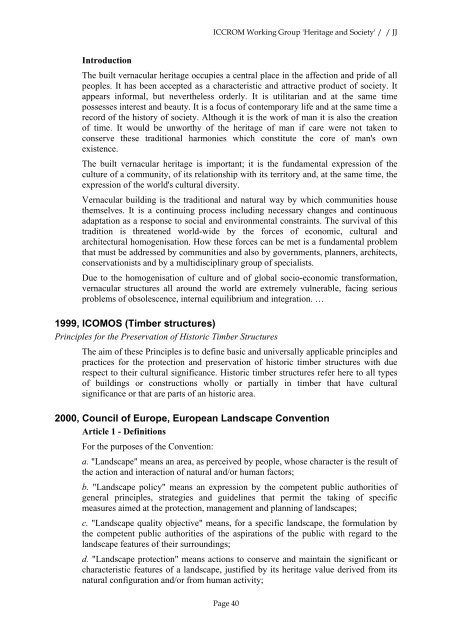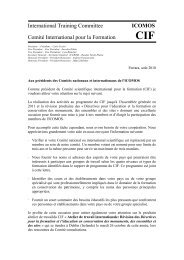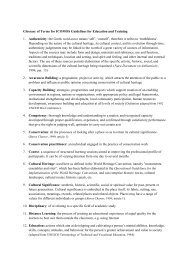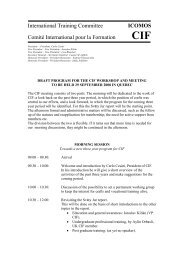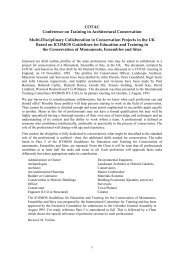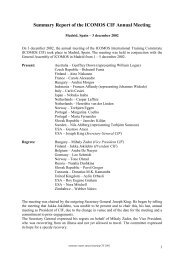Definition of Cultural Heritage -- References to ... - CIF - Icomos
Definition of Cultural Heritage -- References to ... - CIF - Icomos
Definition of Cultural Heritage -- References to ... - CIF - Icomos
Create successful ePaper yourself
Turn your PDF publications into a flip-book with our unique Google optimized e-Paper software.
Introduction<br />
ICCROM Working Group '<strong>Heritage</strong> and Society' / / JJ<br />
The built vernacular heritage occupies a central place in the affection and pride <strong>of</strong> all<br />
peoples. It has been accepted as a characteristic and attractive product <strong>of</strong> society. It<br />
appears informal, but nevertheless orderly. It is utilitarian and at the same time<br />
possesses interest and beauty. It is a focus <strong>of</strong> contemporary life and at the same time a<br />
record <strong>of</strong> the his<strong>to</strong>ry <strong>of</strong> society. Although it is the work <strong>of</strong> man it is also the creation<br />
<strong>of</strong> time. It would be unworthy <strong>of</strong> the heritage <strong>of</strong> man if care were not taken <strong>to</strong><br />
conserve these traditional harmonies which constitute the core <strong>of</strong> man's own<br />
existence.<br />
The built vernacular heritage is important; it is the fundamental expression <strong>of</strong> the<br />
culture <strong>of</strong> a community, <strong>of</strong> its relationship with its terri<strong>to</strong>ry and, at the same time, the<br />
expression <strong>of</strong> the world's cultural diversity.<br />
Vernacular building is the traditional and natural way by which communities house<br />
themselves. It is a continuing process including necessary changes and continuous<br />
adaptation as a response <strong>to</strong> social and environmental constraints. The survival <strong>of</strong> this<br />
tradition is threatened world-wide by the forces <strong>of</strong> economic, cultural and<br />
architectural homogenisation. How these forces can be met is a fundamental problem<br />
that must be addressed by communities and also by governments, planners, architects,<br />
conservationists and by a multidisciplinary group <strong>of</strong> specialists.<br />
Due <strong>to</strong> the homogenisation <strong>of</strong> culture and <strong>of</strong> global socio-economic transformation,<br />
vernacular structures all around the world are extremely vulnerable, facing serious<br />
problems <strong>of</strong> obsolescence, internal equilibrium and integration. …<br />
1999, ICOMOS (Timber structures)<br />
Principles for the Preservation <strong>of</strong> His<strong>to</strong>ric Timber Structures<br />
The aim <strong>of</strong> these Principles is <strong>to</strong> define basic and universally applicable principles and<br />
practices for the protection and preservation <strong>of</strong> his<strong>to</strong>ric timber structures with due<br />
respect <strong>to</strong> their cultural significance. His<strong>to</strong>ric timber structures refer here <strong>to</strong> all types<br />
<strong>of</strong> buildings or constructions wholly or partially in timber that have cultural<br />
significance or that are parts <strong>of</strong> an his<strong>to</strong>ric area.<br />
2000, Council <strong>of</strong> Europe, European Landscape Convention<br />
Article 1 - <strong>Definition</strong>s<br />
For the purposes <strong>of</strong> the Convention:<br />
a. "Landscape" means an area, as perceived by people, whose character is the result <strong>of</strong><br />
the action and interaction <strong>of</strong> natural and/or human fac<strong>to</strong>rs;<br />
b. "Landscape policy" means an expression by the competent public authorities <strong>of</strong><br />
general principles, strategies and guidelines that permit the taking <strong>of</strong> specific<br />
measures aimed at the protection, management and planning <strong>of</strong> landscapes;<br />
c. "Landscape quality objective" means, for a specific landscape, the formulation by<br />
the competent public authorities <strong>of</strong> the aspirations <strong>of</strong> the public with regard <strong>to</strong> the<br />
landscape features <strong>of</strong> their surroundings;<br />
d. "Landscape protection" means actions <strong>to</strong> conserve and maintain the significant or<br />
characteristic features <strong>of</strong> a landscape, justified by its heritage value derived from its<br />
natural configuration and/or from human activity;<br />
Page 40


